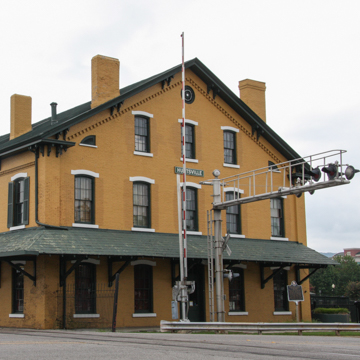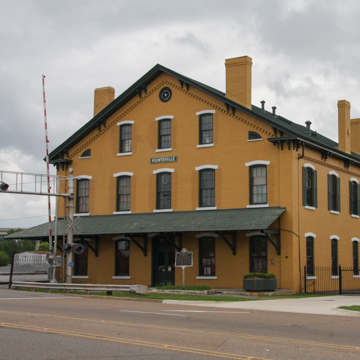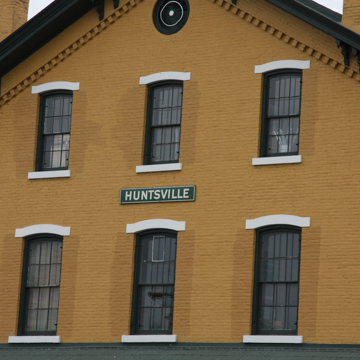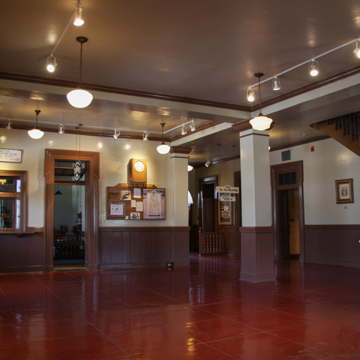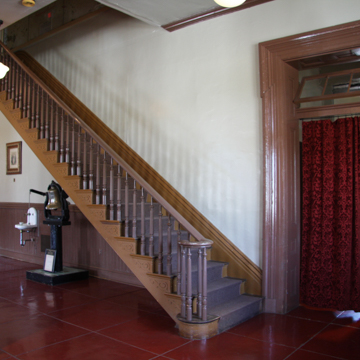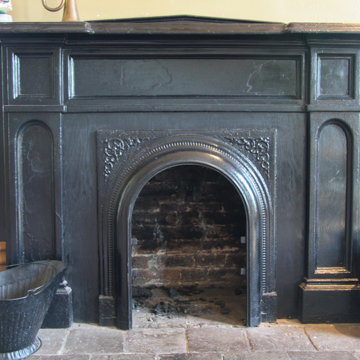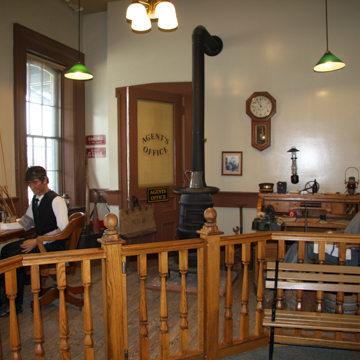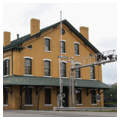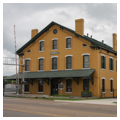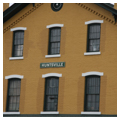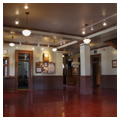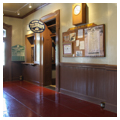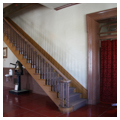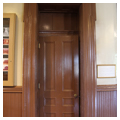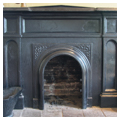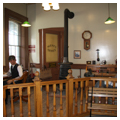You are here
Huntsville Depot and Museum
Located just to the northwest of Huntsville’s historic downtown, the Memphis and Charleston (M&C) Passenger Depot is the oldest standing railway structure in Alabama. Built in 1860, the passenger station also provided office space for the Eastern Division headquarters of the railroad, which encompassed all tracks within the state. It is one of the last remaining buildings of a larger railroad complex; the original brick freight depot, which predated the passenger depot, was located to the north, although all that remains are wall fragments after a 2004 fire. One of the most important railroad lines in the South, the M&C was the first rail line in the United States to link the Atlantic Ocean with the Mississippi River, and significantly contributed to North Alabama’s commercial development.
As early as 1834 the fifty-mile long Tuscumbia, Courtland, and Decatur Railroad had been completed to circumvent the treacherous rapids along the Muscle Shoals portion of the Tennessee River, long an obstacle to navigation. In 1848, the Memphis and Charleston Railroad was incorporated to absorb this line and lengthen it westward to Memphis and eastward to connect to Charleston via Chattanooga. Huntsville citizens were determined for the line to route through their city and in 1849 voted to expend $50,000 towards the proposed railroad. In 1850, the Alabama legislature officially chartered the M&C, and Huntsville was selected to serve as the Eastern Division headquarters. Construction on the Madison County portion of the tracks started in 1851 and by 1855 the first engine, General Garth, began regular service between Huntsville and Tuscumbia.
Because Huntsville served as the eastern headquarters, the site facilities were more substantial here than in other stations. In addition to a large, two-story depot, the railroad also had its shops located in Huntsville. Between 1856 and 1859 the freight depot, a roundhouse with a turntable, engine house, machine shop, and two car shops were built to support the Huntsville site. The railroad also opened a hotel across the tracks from the depot. In 1860, the passenger depot was finished: a two-and-a-half-story, gabled brick structure with a ground level bracketed around two sides, and minor elements of Italianate detailing.
As originally built, the depot’s first floor had large waiting rooms for ladies and gentlemen, engineer’s and conductor’s rooms, a ticket office, and baggage rooms. The second floor housed business offices for the superintendent, secretary, treasurer, and other railroad officials. The uppermost floor held sleeping rooms for both officers and workers. Many of the original fixtures were removed during a 1912 remodel, and extensive rehabilitation work was undertaken in the early 1970s after the city purchased the building.
As the only completed east-west line across the southern states, the M&C was a primary target during the Civil War. In April 1862 Union general Ormsby M. Mitchel captured Huntsville, and was able to break the vital east-west lifeline of the Confederacy. On April 11, Mitchel wired that “We have at length succeeded in cutting the great artery of railway inter-communications between the Southern States.” In addition to controlling about 100 miles of track, the Union captured 15 locomotives and a large number of railroad cars. They also captured 200 Confederate soldiers who were in transit to their units. Prisoners were briefly confined in the depot until two escaped; graffiti left by some of them can still be seen on the top floor. The remaining prisoners were relocated to a federal prison in Ohio. The M&C transported supplies for Union forces in the Western Theater for the remainder of the war.
The railroad was reacquired by the original owners after the war. Of the 155 miles of track in Alabama, 140 miles had been destroyed. Bridges were missing, cross ties had rotted, and iron rails had been heated and wrapped around trees to prevent their reuse. The company never recovered from these losses and by 1877 the M&C was leased to the East Tennessee, Virginia, and Georgia Railroad Company. This was later absorbed by the Southern Railway Company in the 1890s and eventually became part of the present Norfolk and Southern Railroad. Passenger service was discontinued in 1967. Threatened with demolition, in 1971 the depot became the first structure in Huntsville listed on the National Register of Historic Places. That same year, the City of Huntsville purchased the depot, which is now open to the public as a museum.
References
Bayer, Linda. “The Railroad Come to Huntsville.” The Historic Huntsville QuarterlyVII, no. 3 (Spring 1981): 2-10.
Floyd, W. Warner, “Southern Railway System Depot,” Huntsville, Madison County, Alabama, National Register of Historic Places Inventory–Nomination Form, 1971. National Park Service, U.S. Department of the Interior, Washington, D.C.
Gilliam, Catherine. “M&C Stations and Stops.” The Historic Huntsville QuarterlyVII, no. 3 (Spring 1981): 10-22.
Writing Credits
If SAH Archipedia has been useful to you, please consider supporting it.
SAH Archipedia tells the story of the United States through its buildings, landscapes, and cities. This freely available resource empowers the public with authoritative knowledge that deepens their understanding and appreciation of the built environment. But the Society of Architectural Historians, which created SAH Archipedia with University of Virginia Press, needs your support to maintain the high-caliber research, writing, photography, cartography, editing, design, and programming that make SAH Archipedia a trusted online resource available to all who value the history of place, heritage tourism, and learning.




















